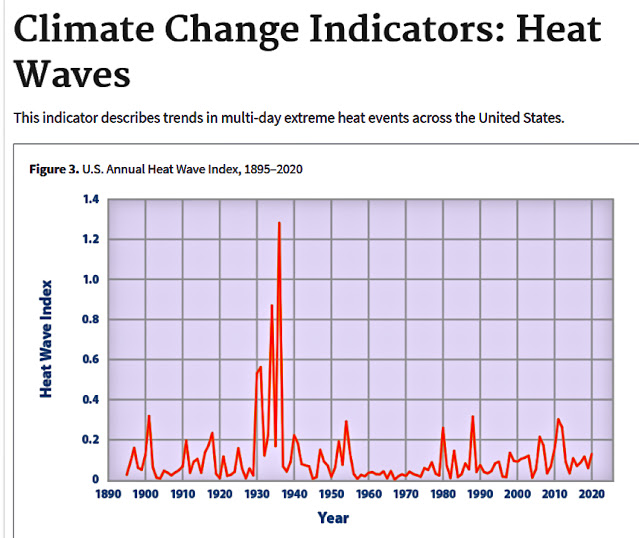Source:
"The frequency (blue chart) is the annual number of calendar days the maximum temperature exceeded the 90th percentile for 1961–1990 for at least six consecutive days.
The EPA’s data is calculated for a period of at least four days, while the heat wave index (red chart) measures the annual magnitude of all heat waves of at least three days in that year combined.
Despite the differences in definition, it’s abundantly clear that heat waves over the last few decades – the ones publicized by the EPA – pale in comparison to those of the 1930s, and even those of other decades such as the 1910s and 1950s.
The peak heat wave index in 1936 is a full three times higher than it was in 2012 and up to nine times higher than in many other years.
The heat wave index shown above actually appears on the same EPA website page as the mimimum-temperature chart.
But it’s presented as a tiny Figure 3 that is only 20% as large as the much more prominent Figure 1 showing minimum temperatures.
As pointed out recently by another writer, a full-size version of the index chart, from 1895 to 2015, was once featured on the website, before the site was updated this year with the new climate change indicators.
 The EPA points out that the 1930s heat waves in North America, which were concentrated in the Great Plains states of the U.S. and southern Canada, were exacerbated by Dust Bowl drought that depleted soil moisture and reduced the moderating effects of evaporation.
The EPA points out that the 1930s heat waves in North America, which were concentrated in the Great Plains states of the U.S. and southern Canada, were exacerbated by Dust Bowl drought that depleted soil moisture and reduced the moderating effects of evaporation. While this is undoubtedly true, it has been suggested by climate scientists that future droughts in a warming world could result in further record-breaking U.S. heat waves.
The EPA has no justification for omitting 1930s heat waves from their data record, or for suppressing the heat wave index chart.
Although the Dust Bowl was unique to the U.S. and Canada, there are locations in other parts of North America and in other countries where substantial heat waves occurred before 1961 as well.
In the summer of 1930 two record-setting, back-to-back scorchers, each lasting eight days, afflicted Washington, D.C.;
while in 1936, the province of Ontario – also well removed from the Great Plains – experienced 43 degrees Celsius (109 degrees Fahrenheit) heat during the longest, deadliest Canadian heat wave on record.
In Europe, France was baked during heat waves in both 1930 and 1947, and many eastern European countries suffered prolonged heat waves in 1946.
What all this means is that the EPA’s heat-wave indicator grossly misrepresents the actual science and defeats its stated goal for the indicators of “informing our understanding of climate change.”"


